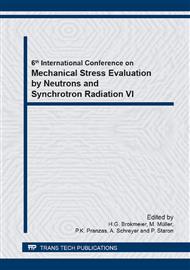p.143
p.149
p.155
p.161
p.167
p.173
p.181
p.187
p.193
Internal Residual Strain Distribution in Chromium-Molybdenum Steel after Carburizing and Quenching Measured by Neutron Strain Scanning
Abstract:
A hollow cylinder specimen of Cr-Mo steel with 0.20 mass% C was used as a model which simplified a motor cycle transmission gear. The specimen was carburized in carrier gas and quenched in oil bath. After quenching, the internal residual strain distributions in the radial, axial and hoop directions were mapped nondestructively by neutron strain scanning, and were compared with results of elastoplastic finite element analysis. The carbon content and hardness gradients were also measured to determine the case depth. Residual strain was calculated from lattice spacing change. In this study, unstressed lattice spacing was determined experimentally by measuring diffraction angle of coupons that were cut from the interior of the same carburized cylinder specimen. As a result, the carbon content and hardness distributions were almost accorded with finite element analysis results. On the other hand, the measured strains in some measuring points discorded with the analyzed weighted average strains. The peak widths in the interior of specimen equaled to that of unstressed coupons. Internal residual strain distributions were complicated and found to be elastic strains that were balanced with equivalent plastic strains due to transformation plasticity of case layer.
Info:
Periodical:
Pages:
173-177
Citation:
Online since:
November 2013
Price:
Сopyright:
© 2014 Trans Tech Publications Ltd. All Rights Reserved
Share:
Citation:


